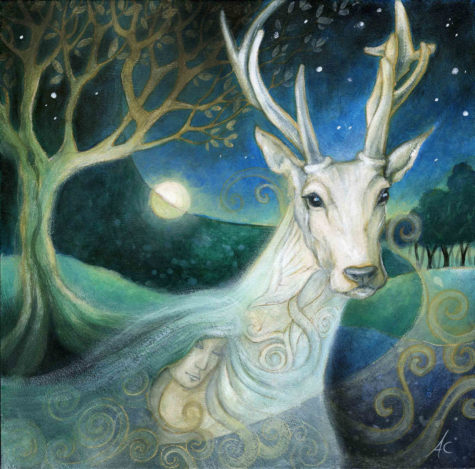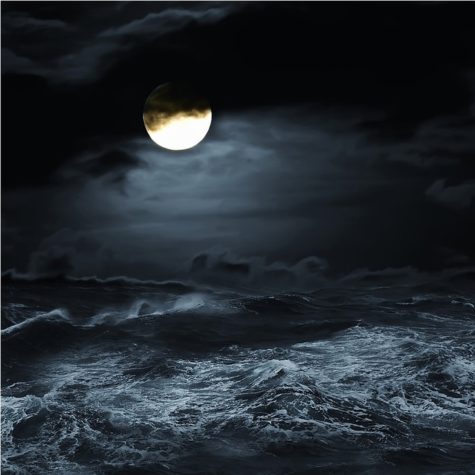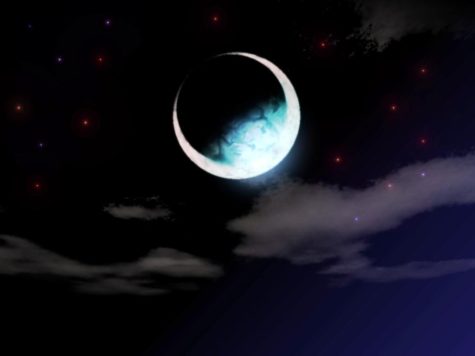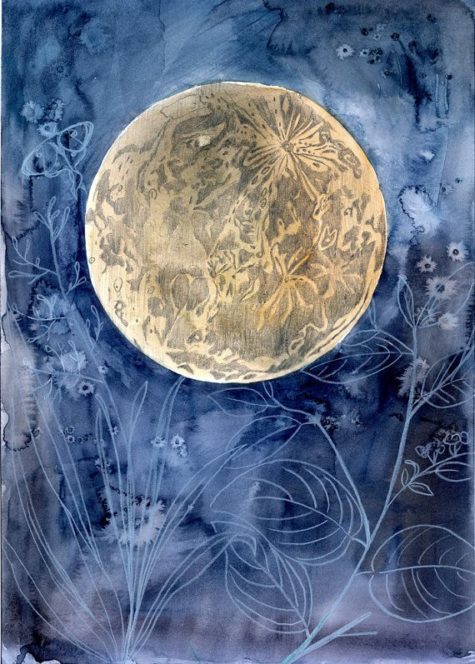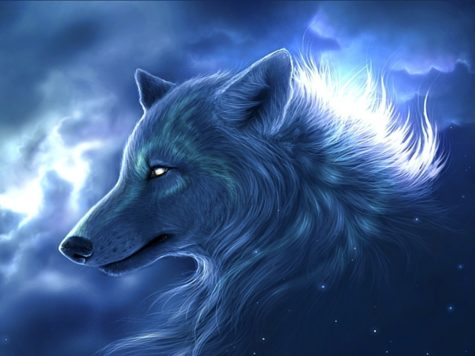Moon
What is a supermoon? The word supermoon didn’t come from astronomy. Instead, it came from astrology. Astrologer Richard Nolle of the website astropro.com takes credit for coining the term supermoon. In 1979, he defined it as:
…a new or full moon which occurs with the moon at or near (within 90% of) its closest approach to Earth in a given orbit (perigee). In short, Earth, moon and sun are all in a line, with moon in its nearest approach to Earth.
By this definition, according to Nolle, there are 4-6 supermoons a year on average.
The full moon of November 14, 2016 is not only the biggest, closest and brightest supermoon of this year. It’s the closest supermoon since January 26, 1948. Should you watch for this full moon on the night of November 14? Sure, and, if you do, it’ll be beautiful. But, for us in the Americas the moon is closer to full on the night of November 13.
The moon turns precisely full on November 14, 2016 at 13:52 UTC. This full moon instant will happen in the morning hours before sunrise November 14 in western North America and on many Pacific islands, east of the International Date Line. (See worldwide map below.)
In Asia and Australia, the moon turns precisely full during the evening hours of November 14. In New Zealand, it actually happens after midnight November 15. Around the longitudes of Europe or Africa, look both nights.
Better yet … everyone, look both nights!
The moon will look plenty full and bright all night long on both nights – November 13 and 14 – as it rises in the east around sunset, climbs highest up around midnight, and then sets in the west at or near sunrise.
The moon won’t come this close to Earth again until November 25, 2034.
Astronomers call this sort of close full moon a perigee full moon. The word perigee describes the moon’s closest point to Earth for any given month. Five years ago – when the closest and largest full moon fell on March 19, 2011 – many began using the term supermoon. In the following years, we heard this term again to describe the year’s closest full moon on May 6, 2012, and again on June 23, 2013, and again on August 10, 2014, and yet again on September 28, 2015.
Now the term supermoon is being used a lot, and, personally, we approve! It’s a good descriptive term for the closest full moons, much easier to remember than perigee full moon.
Last month’s full moon – on October 16, 2016 – was also a supermoon. But the November full moon is even more super! In other words, the time of full moon falls even closer to the time of the moon’s closest point to Earth.
The next supermoon falls on December 3, 2017.
Source: EarthSky
July is normally the month when the new antlers of buck deer push out of their foreheads in coatings of velvety fur. It was also often called the Full Thunder Moon, for the reason that thunderstorms are most frequent during this time. It is known as the Hay Moon or the Meadow Moon because the meadows are at their greatest point of growth in this month, and it is a time for hay-cutting. Other names for this month’s Moon include: Blood Moon, Grain Moon, Green Corn Moon, Herb Moon, Hungry Ghost Moon, Wort Moon.
Native American fishing tribes called it the Sturgeon Moon because sturgeon, a large fish of the Great Lakes and other major bodies of water, were most readily caught during this month. A few tribes knew it as the Full Red Moon because, as the Moon rises, it appears reddish through any sultry haze.
The energies surrounding this full moon are ones of success, happiness, and fulfilment. We are blessed with the first harvest of the season – a reward for all our hard work. For this reason, July’s full moon is also known as the Blessing Moon. Energy moves into creation. Opportunities for self-reliance and confidence, unity and balance abound.
The Moon at this time brings us feelings of being connected. Connection to Spirit encourages us to first recognize blessings in our own lives, and then pay them forward – thus continuing the cycle of positive energy.
Correspondences:
- Colors: Green, silver, blue-gray
- Gemstones: Moonstone, white agate, opals or pearls
- Trees: Ash and oak
- Gods: Juno, Venus, Cerridwen, Athena, Nephthys, Lugh
- Herbs: Mugwort, hyssop, lemon balm
- Element: Water
This is a great time to do divination and dreamwork. Find a way to incorporate the watery energy of the Blessing Moon into your spell crafting and ritual. Enjoy the relaxing feeling of July’s full moon and use it in your personal meditation.
Celebrating the Full Buck Moon:
- Wear shades of green to honor the herb harvest
- Adorn your hair and altar with herbs and greenery
- Burn sage, lavender or rosemary incense
- Prepare herbal tea and lavender or lemon balm cookies
- Bless your herb garden
Collected from various sources
The first (or only) full moon in June is called the Honey Moon. Tradition holds that this is the best time to harvest honey from the hives.
Correspondences:
- Colors: Sun colors — gold, yellow, orange
- Gemstones: Topaz, agate
- Trees: Oak, maple
- Gods: Isis, Cerridwen, Persephone
- Herbs: Parsley, mosses, skullcap, mugwort
- Element: Earth
This is the month where magical workings are well suited to maintaining and enhancing things you already have. Weed your garden, prune the bushes, give your lawn all the tender loving care it needs. Take time to let your personal life blossom as well – focus on things that improve your job or education, as well as your relationships with family and friends.
This time of year, between the planting and harvesting of the crops, was the traditional month for weddings. This is because many ancient peoples believed that the “grand [sexual] union” of the Goddess and God occurred in early May at Beltaine. Since it was unlucky to compete with the deities, many couples delayed their weddings until June.
June remains a favorite month for marriage today. In some traditions, newly wed couples were fed dishes and beverages that featured honey for the first month of their married life to encourage love and fertility. The surviving vestige of this tradition lives on in the name given to the holiday immediately after the ceremony: “The Honeymoon.”
In June, we’re beginning to see some early summer fruits and vegetables (a great time for strawberry crops!), and the days are getting longer and longer. It’s a far cry from the darkness of winter, and we typically try to spend as much time outside as possible. Also known as Lover’s Moon, Long Sun Moon, it’s a time for bonding with friends and family, and forging what connections we can. Nurture your relationships, your garden, your career, and your soul this month.
In pre-historic times, summer was a joyous time of the year for those Aboriginal people who lived in the northern latitudes. The snow had disappeared; the ground had thawed out; warm temperatures had returned; flowers were blooming; leaves had returned to the deciduous trees. Some herbs could be harvested, for medicinal and other uses. Food was easier to find. The crops had already been planted and would be harvested in the months to come.
A Storm moon is, according to weather folklore, the moon which occurs in March during shifting weather patterns in the northern hemisphere.
This is the month when Spring finally arrives, around the time of the Equinox, and we see new life begin to spring forth. As the Wheel of the Year turns once more, heavy rains and gray skies abound — the earth is being showered with the life-giving water it needs to have a fertile and healthy growing season. This is also a time of equal parts light and darkness, and so a time of balance.
Correspondences:
- Colors: Green, yellow, light purple
- Gemstones: Bloodstone, aquamarine
- Trees: Dogwood, honeysuckle
- Gods: Isis, the Morrighan, Artemis, Cybele
- Herbs: High John, pennyroyal, wood betony, apple blossom
- Element: Water
Use this month for magical workings related to rebirth and regrowth. New life is blooming during this phase of the moon, as is prosperity and fertility.
More March moon lore:
As the temperature begins to warm and the ground begins to thaw, earthworm casts appear, heralding the return of the robins. The more northern Native American tribes knew this Moon as the Full Crow Moon, when the cawing of crows signaled the end of winter; or the Full Crust Moon, because the snow cover becomes crusted from thawing by day and freezing at night.
The Full Sap Moon, marking the time of tapping maple trees, is another variation. To the settlers, it was also known as the Lenten Moon, and was considered to be the last full Moon of winter.
It is also called seed moon, moon of winds, crow moon, moon of the snow-blind, and Full Worm Moon.
Source: Unknown
The lunar eclipse is the symbol of the Crone, also called Hecate, Hel, Mother Hulda, the Snow Queen, Bone Mother, Demeter (when searching for Persephone and the earth’s vegetation dies) and Sekhmet. It is significant that the eclipse does not related to the Crone as Lady of Wisdom, who is part of the Crone image with the waning crescent-moon part of the lunar cycle, but focuses on the Lady as Passage. Now is a fine time for Dark magic and Sidhe magic.
The Lady as Passage offers transit between the worlds to Otherworld and the Sidhe, and her moon is the best time for magic involving Other People, or for seeking a companion from the Otherworld.
This lunar event additionally provides a person with the opportunity of drawing the subconscious, intuitive mind, which draws upon the Goddess as Transformer. She is the Dark Lady of the subconscious, intuitive mind, who then transforms the practitioner’s innate desire/will into reality as She Herself changes into the Mother. She gives birth to your desire in a ritual or meditation.
You focus on what it is you want, and as the Moon passes into darkness, envision the desire being gathered by the Crone, then passed into the arms of the Maiden as the sliver of Moon appears heralding the ending of the eclipse, and brought into manifestation by the Mother as the Moon is finally revealed.
From: Green Witchcraft II
The full moon in February is known as the Quickening moon, it marks the official end of winter, and the quickening, the renewal of all things. While the skies are still gray, and the weather is cold, beneath the surface life begins to secretly stir.
This moon phase is a time of abundance, ripening and completeness, heavy with fertility and female divinity. It is a time when the potential of all things begins to stir towards birth in spring, a time to work on our own inner power and confront personal truths in preparation for birth. This moon sheds enough light to help us see into our darkness, so that our energy can make its way to the surface to prepare for growth and healing.
This is the season of Imbolc, the days when we know that if we can just hold on for a few more weeks, we might get lucky and see little green shoots peeking out through the snow and slush.
Correspondences:
- Colors: Purple and blue
- Gemstones: Rose quartz, amethyst, jasper
- Trees: Rowan, Myrtle
- Gods: Brighid, Aphrodite, Juno, Mars
- Herbs: Hyssop, sage, myrrh
- Element: Fire
The word Quickening is also used to describe the first moment in pregnancy when a woman feels the movements of her baby. So too, this a time when new life is beginning, but still lies dormant. Pregnant animals, due in the spring, begin to feel the quickening of their unborn young. The earth itself is quickening, as seeds and bulbs far beneath the soil begin their journey towards the light. We know these things are coming — and we know also that this is a good month to make plans for the future. We can dream and hope, and set goals for ourselves. Accept responsibility for mistakes you’ve made in the past, and move on.
Magical workings this month should focus on personal achievements and advancement. This is an excellent time for fertility and childbirth spells.
From various sources
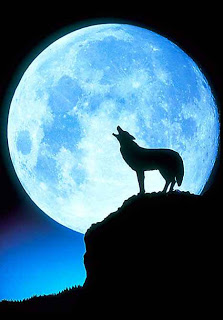 Tonight is the night of the Wolf Moon. This first full moon of the new year is a time of silence and sitting by the home fire. As the wild winter howls, appreciate the warmth of home and family.
Tonight is the night of the Wolf Moon. This first full moon of the new year is a time of silence and sitting by the home fire. As the wild winter howls, appreciate the warmth of home and family.
Now is the time to go within and plan the changes you will make in the spring. Consider now what you will plant. Start a moon journal to record your lunar tides and write down your spring dreams.
Correspondences:
- Colors: Black and white, silver
- Gemstones: Hematite
- Trees: Birch, Hazel
- Gods: Inanna, Freyja
- Herbs: Thistle, nuts and seeds, marjoram
- Element: Air
Full Moon names started with Native Americans as tribes kept track of the seasons by giving distinctive names to each recurring full Moon. The names actually applied to the entire month in which each occurred. There was some variation in the names based on tribes. European settlers followed that custom and created some of their own names.
Sometimes it is also referred to as the Cold Moon, Old Moon, or the Moon After Yule. Some called it the Full Snow Moon, but Wolf Moon seems most appropriate, in native cultures, because amid the cold and deep snows of midwinter, the wolf packs howled hungrily outside their small villages, huts, and teepees. Since the lunar month is only 29 days long on the average, the full Moon dates shift from year to year.
This is a good time to work on magic related to protection, both physical and spiritual. Use this time to develop your inner self, and advance spiritually, becoming closer to the higher aspects of your deities.
More about the Full Wolf Moon
It’s been a tough month for some of us. I thought it fitting to toss out some symbolic observations about the January Wolf Moon with a goal to offer inspiration to folks facing some challenges right now.
- Lunar Symbolism:
Before blasting off into Wolf Moon symbolism, let’s take a look at lunar implications. Subtle, cunning and soft in silky shadows, the moons meanings can be slippery. But, to those who grasp moon symbolism, great insights follow. Typically feminine in archetypal understanding, the moon carries themes of cycles and fertility.
Moreover, the moon conveys a kind of creativity that is born from veiled magic. Consider the moon’s growth cycles (waxing, full, waning, new). These phases are wrought from the moon’s movement. And, the manifestation of her development is made known to us through light and shadow.
What’s the symbolic lesson here? Progress is sometimes subtle. Manifestations of evolution often occur behind the scenes, in shadow – before we “see the light” or the end-product of our vision.
When contemplating this month’s full moon and its partnership with the Wolf, we must not cram our intellect into the void. Rather, the Wolf Moon asks us to use intuitive instinct in soft ways.
The gifts of this full moon come to our senses like steam rising over sacred waters marbled with frosty stillness.
Wolf Symbolism and Wolf Moon Solutions:
Strategic, resourceful and incredibly communicative, the Wolf is a noble mentor for humankind. Wolves have specific protocol and rank within their packs. This observation is a cue to look to community for creative solutions during this full moon. Communicate with those in your pack to help you with your challenges. But don’t break taboo. If you follow specific traditions in social communication, hold to them. In fact, use this full moon to honor traditions of your heritage. Take time to honor your elders too. Tribal rituals should be heeded this time of year.
Wolves are vastly expressive. Sure, their vocalizations (baling, howling and barking) are legendary, but Wolves also have an complex system of body language and even eye contact to convey intent and current state of being. Discipline in the pack is rarely corporeal. Rather, behavior is admonished or reinforced by intricate expressions. One look from the Alpha can convey as much power as a physical blow.
There’s big medicine in this. Use this full moon to get in touch with your own modes of expression. Explore your own eye contact and body language. Examine yourself in the mirror (yes, I’m serious) as you’re talking on the phone. View yourself objectively. What are your expressions conveying? How can you modify or enhance your body language to portray more authority or power? Or, perhaps more softness and sensuality is needed. Too often we are unconscious about our eye and body movements in the scheme of social interaction. This is a great time to ponder these nuances of communication.
Wolves are also phenomenally resourceful. In fact, their resourcefulness is partly why this moon carries the Wolf moniker. January is a brutal month in the northern regions. The frigidity of winter crunches life to a stand-still in the wild. To be sure, it’s a time of “sink or swim” to all wildlife exposed to the elements this time of year.
Wolves, however, often thrive during this lean month. They are designed to handle the brutality of cold quite well. Furthermore, as Wolves are inclined to pick off weaker animals, January offers up a host of feasting options. Perhaps we can use the resourcefulness of the Wolf to reconsider our options in life. Maybe what seems bleak or lame in our life is actually an invitation for opportunity. Food for thought.
I hope these symbolic ideas about the cold Wolf Moon inspire you to take advantage of January’s lunar fullness. Take a pause on the evening of this month’s full moon to contemplate your own inner wisdom too. I bet your findings will be illuminating.
~collected from various sources, including Symbolic Meanings
What follows is a list (in alphabetical order) of the names given to the January moon. Also listed is the tradition and/or origin of that moon name:
- Avunniviayuk ~Inuit
- Big Cold Moon ~Mohawk
- Chaste Moon ~other
- Cold Meal Moon ~Natchez
- Cold Moon ~Cheokee
- Cooking Moon ~Choctaw
- Dark Moon ~Janic
- Disting Moon ~other
- Flying Ant Moon ~Apache
- Great Spirit Moon ~Anishnaabe
- Her Cold Moon ~Wishram
- Ice Moon ~San Juan, Neo-Pagan
- Icicle Moon ~Medicine Wheel
- Joyful Moon ~Hopi
- Little Winter Moon ~Creek
- Man Moon ~Taos
- Moon After Yule ~Cherokee
- Old Moon –Algonquin
- Quiet Moon ~Celtic, Janic
- Snow Moon ~other
- Storm Moon ~other
- Strong Cold Moon ~Sioux, Cheyenne
- Whirling Wind Moon ~Passamaquoddy
- Winter Moon ~Algonquin
- Wolf Moon ~Medieval English, Janic

